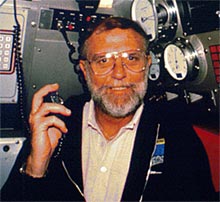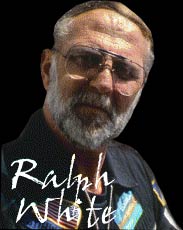Loch Ness Monster Filmmaker Dies
Posted by: Loren Coleman on February 13th, 2008

Ralph Bradshaw White, 66, a National Geographic contract cameraman who filmed the documentary Search for the Loch Ness Monster, died February 4, 2008, at the Glendale Adventist Medical Center in California, the Los Angeles Times announced on February 13. White died from complications of an aortic aneurysm, said his daughter, Krista Few of Yokosuka, Japan.
White was most famous, in filmmaking circles, for his gripping footage that documented the 1985 discovery of the sunken Titanic. He had returned to the bottom of the ocean more than 30 times to film and recover artifacts from the ill-fated vessel.
Ralph White enjoyed a very distinguished professional career as an award winning cinematographer, a video cameraman and editor with over thirty years of production experience and hundreds of motion picture and television credits.
White was one of the few people experienced in the methodology and technology required to safely reach the deep ocean depths in order to acquire images.
It was in 1985 that White documented the expedition that found the wreck of the RMS Titanic, and in 1987, and 2000, he co-directed the salvage operation and photography during the recovery of over 5000 artifacts from the Titanic’s debris field.
White was the submersible cameraman for the 1991 IMX feature film Titanica, and in 1995-1996, he was the expedition leader and second unit cameraman for James Cameron’s Academy Award winning feature film, Titanic. White made 33 dives to the -12,000 foot deep wreck of the Titanic and was qualified as a copilot of the French Nautile and Russian Mir submersibles.
For more than 25 years, White served as a contract cameraman for the National Geographic Society, where he helped pioneer the development of advanced remote cameras, 3-D video, HDTV, and deep ocean imaging and lighting systems. He photographed a huge array of marine creatures, including the largest ever seen flesh-eating shark, a 30 ft Somniosus pacificus.
His NGS assignments included the Discovery of Active Volcanic Vents along with their unique biological colonies in the deep waters of the east Pacific rise and Mid-Atlantic ridges. He utilized large screen format to document those deep ocean dives, including the two mile deep “Black Smoker” vents of the East Pacific Rise, the 400 degree hot vents in the Mid-Atlantic Ridge, and the World Record submersible rendezvous at 16,500 feet.
White filmed the first multinational Exploration of Lake Baykal, in remote Siberia. He had been to both poles, and filmed the 153-year-old wreck of the HMS Breadalbane under the Arctic ice cap. Other NGS credits included documentaries about, as noted, Loch Ness, but also films on Suruga Bay, Wild Horses, Reptiles, Sharks, and The Beebe Project.
His film, The Great Whales won the coveted “Emmy” Award for Best Documentary in 1977. White’s cinematography also won the Grenoble Film Festival Gold Medal, the Golden Eagle, the Cindy and the Golden Halo awards.
White was one of the field producers and cameramen for the Alan Landsburg television series Those Amazing Animals and That’s Incredible, as well as Bill Burrud’s Animal World, Challenging Sea, Treasure, Islands In The Sun, True Adventures, The Wonderful World of Women, and Wanderlust.

White was one of the innovators in documenting the behind-the-scenes makings of a major motion picture with Columbia’s The Deep, 20th Century Fox’s Tora-Tora-Tora, and The Valley Of The Dolls. He co-hosted and was a segment producer and cameraman for Jack Douglas’ Adventure and Journey series. He covered the thrills of victory for ABC’s Wide World of Sports, NBC’s Sports In Action, and CBS’ Sports Spectacular.
He was operations supervisor of the Medusa ROV for James Cameron’s 3D IMAX film Ghosts Of The Abyss and technologies coordinator for James Cameron’s live broadcast from the deck of the ship for the Discovery Channel’s Last Mysteries of Titanic. He was also the deep sea imaging and guest wreck expert for the History Channel’s Titanic’s Last Moments, which aired only recently.
Ralph White was a highly qualified helicopter and astrovision aerial specialist and a former Member of the United States parachute Team. He co-invented the Bell Camera Helmet that he used in the filming of free fall skydiving sequences for Ivan Tors Ripcord Series. White served in the US Marine Corps as a Force Reconnaissance Team Leader and he was a highly decorated reserve Forces Captain who commanded the elite and award winning Los Angeles County Sheriffs Department Photographic Unit.
White had been awarded the titles of Knight, Order of Saint Lazarus and Knight, Order of Constantine, for his filming and conservation accomplishments. His extensive experience was well recognized by his peers: he was a Fellow of the Royal Geographical Society, a Fellow and Recipient of the Lowell Thomas Award for Life Achievement from the Explorers Club, a NOGI Fellow, and he was Past President of AUAS and of The Adventurers Club.
“I was born an adult in search of a childhood. And I’ve been very successful at that,” White said in a 1998 article in the Las Vegas Review-Journal.
Born Aug. 28, 1941, in San Bernardino, White grew up on the Big Island of Hawaii.
Ralph White is survived by his fiancee Rosaly Lopes; his daughter, Krista Few; his son, Randy Pixley of Atlanta; two grandchildren, Samantha and Nicholas; and Lopes’ son Thomas Gautier.
About Loren Coleman
Loren Coleman is one of the world’s leading cryptozoologists, some say “the” leading living cryptozoologist. Certainly, he is acknowledged as the current living American researcher and writer who has most popularized cryptozoology in the late 20th and early 21st centuries.
Starting his fieldwork and investigations in 1960, after traveling and trekking extensively in pursuit of cryptozoological mysteries, Coleman began writing to share his experiences in 1969. An honorary member of Ivan T. Sanderson’s Society for the Investigation of the Unexplained in the 1970s, Coleman has been bestowed with similar honorary memberships of the North Idaho College Cryptozoology Club in 1983, and in subsequent years, that of the British Columbia Scientific Cryptozoology Club, CryptoSafari International, and other international organizations. He was also a Life Member and Benefactor of the International Society of Cryptozoology (now-defunct).
Loren Coleman’s daily blog, as a member of the Cryptomundo Team, served as an ongoing avenue of communication for the ever-growing body of cryptozoo news from 2005 through 2013. He returned as an infrequent contributor beginning Halloween week of 2015.
Coleman is the founder in 2003, and current director of the International Cryptozoology Museum in Portland, Maine.










WOW…What an amazing life!!!
Godspeed sir. On to discover new magical worlds.
He lived his dream and was held in esteem by his peers. He will be missed.
Rest in peace. He lived an incredible life filled with amazing experiences.